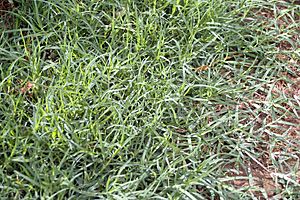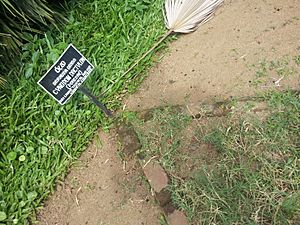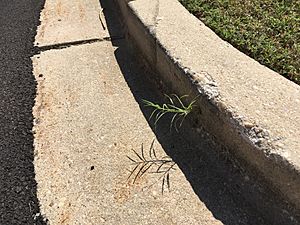Bermuda grass facts for kids
Quick facts for kids Bermuda grass |
|
|---|---|
 |
|
| Scientific classification | |
| Genus: |
Cynodon
|
| Species: |
dactylon
|
| Synonyms | |
|
List
|
|
Cynodon dactylon, often called Bermuda grass, is a type of grass found all over the world. It's also known by many other names like Dhoob, dūrvā grass, dog grass, Bahama grass, and wiregrass. This grass originally comes from Europe, Africa, Australia, and most of Asia. It was later brought to the Americas. Even though it's not from Bermuda, it grows a lot there and is considered an invasive species.
Contents
What is Bermuda Grass?
The blades of Bermuda grass are usually a grey-green color. They are short, typically about 2 to 15 centimeters (1 to 6 inches) long, and have rough edges. The stems stand upright and can grow from 1 to 30 centimeters (less than an inch to about a foot) tall. These stems are a bit flat and often have a purple tint.
The seeds grow in a group of two to six spikes at the very top of the stem. Each of these spikes is about 2 to 5 centimeters (1 to 2 inches) long.
How Bermuda Grass Grows and Spreads
Bermuda grass has a deep root system. In dry conditions, if the soil is easy to grow through, its roots can go deeper than 2 meters (6.5 feet). However, most of its roots are found less than 60 centimeters (2 feet) below the surface.
This grass spreads by creeping along the ground using special stems called stolons. Wherever a node (a joint on the stem) touches the ground, new roots grow, forming a thick mat. Bermuda grass can also reproduce using seeds and underground stems called rhizomes.
It starts to grow when temperatures are above 15°C (59°F). It grows best when the temperature is between 24°C and 37°C (75°F and 99°F). In winter, the grass stops growing and turns brown. It loves full sun and doesn't grow well in shady spots, like close to tree trunks.
Where Bermuda Grass is Grown
Bermuda grass is grown widely in warm parts of the world. You'll find it in areas between about 30° South and 30° North latitude. It needs between 625 and 1750 millimeters (25 to 69 inches) of rainfall each year, or it needs to be watered. For example, in the U.S., it's mostly grown in the southern states.
Different Types of Bermuda Grass
There are hundreds of different types, or cultivars, of Bermuda grass. These have been created to handle different environments or to meet specific needs. New types are developed every year.
Uses of Bermuda Grass
Religious Importance
In India, Bermuda grass is often called "durva" or dūrvāyugma. It's used in the Ayurveda system of medicine. In Hinduism, this grass is very important for worshipping Lord Ganesha. People often offer a bundle of 21 shoots of this grass during a special prayer ceremony called pooja. It has been part of Hindu traditions for a very long time. There's even a special festival called Durva Ashtami, which celebrates this grass.
In Kerala, India, it's known as "Karuka" and is one of the Dashapushpam (Ten sacred flowers).
In Nepal, the grass is called dubo in Nepali. Hindus use it for worship because they believe it symbolizes a long life. It's an important part of festivals like Naga Panchami and Gaura festival. In Nepalese Khas Hindu weddings, both the bride and groom wear a garland made from this grass.
This grass is also a Yoruba herb used for Esu or Elegba in the Ifá Orisa System.
Medicinal Uses
The underground stems (rhizomes) of Bermuda grass are believed to help the body get rid of extra water. The juice from the grass can also help tighten body tissues.
It's been noticed that dogs sometimes eat Bermuda grass to make themselves vomit quickly when they have tummy troubles. This might be because of tiny bristles on the edges of the leaves that can cause irritation.
Other Practical Uses
Bermuda grass grows quickly and is very tough. This makes it a popular choice for sports fields because it recovers fast if it gets damaged. It's a great grass for lawns in warm areas, especially where it's hot and dry, because it can survive when other grasses can't. This is why it's often used on golf courses in the southern U.S. and South Africa. There are many different types of Bermuda grass chosen for various lawn needs.
Bermuda grass has also been grown in salty soils in California's Central Valley. These soils were too salty for regular farm crops. The grass was successfully watered with salty water and used to feed cattle.
Where You Might See It: Sports Fields
Bermuda grass is a popular choice for many professional sports fields because of its toughness and ability to recover quickly. Here are some examples:
- State Farm Stadium in Glendale, AZ (Tifway 419 Hybrid Bermudagrass)
- M&T Bank Stadium in Baltimore, MD (Tifway 419 Bermudagrass)
- Arrowhead Stadium in Kansas City, MO (Latitude 36 Bermuda Grass)
- FedEx Field in Landover, MD (Latitude 36 Bermuda Grass)
- Nissan Stadium in Nashville, TN (Tifsport Bermuda Sod)
- Allegiant Stadium in Paradise, NV
- Levi's Stadium in Santa Clara, CA (Tifway II Bermuda Grass)
- TIAA Bank Field in Jacksonville, FL (Tifway 419 Bermudagrass)
- Hard Rock Stadium in Miami, FL (Tifway 419 Bermudagrass)
- Raymond James Stadium in Tampa, FL (Tifway 419 Bermudagrass)
- Soldier Field in Chicago, IL (Tahoma 31 Bermudagrass)
- Angel Stadium in Anaheim, CA (Tifway 419 Bermudagrass)
- Dodger Stadium in Los Angeles, CA (Santa Ana Bermudagrass)
- Oakland Coliseum in Oakland, CA (Tifway II Bermuda Grass)
- Petco Park in San Diego, CA (BullsEye Bermuda Grass)
- Oracle Park in San Francisco, CA (Tifway 419 Bermudagrass)
Bermuda Grass in Nature
Is it an Invasive Species?
Bermuda grass is a very strong invasive species. This means it spreads quickly and can take over areas, pushing out other grasses and plants. It can be a difficult weed to get rid of in some places. Gardeners sometimes call it "devil grass" because it's so hard to control in flower beds. While some special products can help, they are often sold to professional landscapers.
Some types of Bermuda grass, like the hybrid variety Tifton 85, can produce certain natural substances. If animals eat a lot of these specific types of grass under certain conditions, these substances might not be good for them.
See also
 In Spanish: Grama común para niños
In Spanish: Grama común para niños





